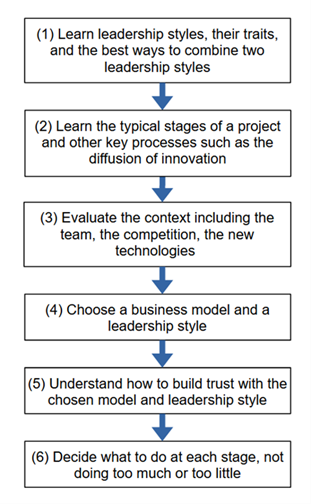When we think of great leaders, we turn to famous leaders from history for inspiration, but they did not have to deal with unpredictable disruption AI is causing. The modern leader must not only lead humans, but also autonomous AI agents. They must also guide the organization through the process of adapting to fully utilize AI across all the operations. There is no simple answer to this challenge, but there is a structured approach with six steps that will increase the chances of success.

Figure 1. The steps to being a great leader in the age of AI
Step 1: Learn the three most effective leadership styles
The first step is to learn the three most effective leadership styles and understand the benefits of combining them in various ways. These are servant, transactional and transformational.
Step 2: Learn the typical stages of a project
The modern leader must constantly integrate the latest versions of AI so their role becomes similar to that of a project manager implementing a series of digital transformation projects. Typically, a project has six stages that are forming, storming, norming, performing, adjourning and post-project collaboration.
Step 3: Evaluate the context
While we are fascinated by the capabilities of AI, the role of the context the leader finds themselves in must not be underestimated. The leadership approach must consider the influence of the context on the people and the technology.
Step 4: Choose a business model and a leadership style
The leader needs to think about whether to focus on one of the three leadership styles or combine two of them to get the best out of the situation they are in.
Choosing a proven AI centred business model will offer clarity. There are six proven AI focused business models: first: incumbent focusing on one part of the value chain and disaggregating, second: incumbent absorbing AI into existing model, third: incumbent expanding beyond current model to fully utilise the opportunities of AI and access new data, fourth: startup disruptor focused on one sector, built from the start to be highly automated, fifth: disruptor focused on tech adding a new service such as insurance, and lastly the sixth model is a disruptor that is not tech-focused but has an extensive userbase.
Step 5: Build trust with a clear vision of what the role of AI is
To lead autonomous AI agents, the leader must build trust in them among the team. The leader must be clear on their use and build a consensus around this. The team must be put on a sustainable trajectory for change.
Step 6: Decide what to do at each stage of the project
Effective leadership today must involve leading on technology as well as people, building trust in the technology, and finding the best combination of leadership styles to get the most out of humans and automated AI agents. These many tasks cannot all be done at once so the leader must have a plan of what they will focus on at each stage.
The steps touched on here are covered more thoroughly in the book. If you want to learn more about Leadership in AI with trust you can buy my book from all good bookshops.
Reference
Zarifis A. (2025) ‘Leadership with AI and trust: Adapting popular leadership styles for AI’, De Gruyter: Berlin. https://doi.org/10.1515/9783111630137
https://www.amazon.co.uk/Leadership-AI-Trust-Adapting-leadership/dp/3111630048
https://blackwells.co.uk/bookshop/product/Leadership-With-AI-and-Trust-by-Alex-Zarifis/9783111630045